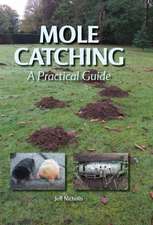Ecological Systems: Selected Entries from the Encyclopedia of Sustainability Science and Technology
Editat de Rik Leemansen Limba Engleză Paperback – 28 ian 2015
| Toate formatele și edițiile | Preț | Express |
|---|---|---|
| Paperback (1) | 945.47 lei 43-57 zile | |
| Springer – 28 ian 2015 | 945.47 lei 43-57 zile | |
| Hardback (1) | 949.73 lei 43-57 zile | |
| Springer – 11 dec 2012 | 949.73 lei 43-57 zile |
Preț: 945.47 lei
Preț vechi: 1153.02 lei
-18% Nou
Puncte Express: 1418
Preț estimativ în valută:
180.91€ • 189.40$ • 149.70£
180.91€ • 189.40$ • 149.70£
Carte tipărită la comandă
Livrare economică 07-21 aprilie
Preluare comenzi: 021 569.72.76
Specificații
ISBN-13: 9781489986900
ISBN-10: 1489986901
Pagini: 316
Ilustrații: VI, 310 p.
Dimensiuni: 155 x 235 x 17 mm
Greutate: 0.45 kg
Ediția:2013
Editura: Springer
Colecția Springer
Locul publicării:New York, NY, United States
ISBN-10: 1489986901
Pagini: 316
Ilustrații: VI, 310 p.
Dimensiuni: 155 x 235 x 17 mm
Greutate: 0.45 kg
Ediția:2013
Editura: Springer
Colecția Springer
Locul publicării:New York, NY, United States
Public țintă
Upper undergraduateCuprins
1. Ecological Systems, Introduction.- 2. Atmospheric Biogeochemistry.- 3. Ecological Succession and Community Dynamics.- 4. Ecosystem Engineers, Keystone Species.- 5. Ecosystem Flow Analysis.- 6. Ecosystem Services.- 7. Ecosystems and Spatial Patterns.- 8. Ecosystems, Adaptive Management.- 9. Ecotones and Ecological Gradients.- 10. Invasive Species.- 11. Landscape Ecology.- 12. Marine Biogeochemistry.- 13. Species Competition and Predation.- 14. Species Diversity Within and Among Ecosystems.- 15. Urban Ecology.- Index.
Textul de pe ultima copertă
Earth is home to an estimated 8 million animal species, 600,000 fungi, 300,000 plants, and an undetermined number of microbial species. Of these animal, fungal, and plant species, an estimated 75% have yet to be identified. Moreover, the interactions between these species and their physical environment are known to an even lesser degree. At the same time, the earth’s biota faces the prospect of climate change, which may manifest slowly or extremely rapidly, as well as a human population set to grow by two billion by 2045 from the current seven billion. Given these major ecological changes, we cannot wait for a complete biota data set before assessing, planning, and acting to preserve the ecological balance of the earth. This book provides comprehensive coverage of the scientific and engineering basis of the systems ecology of the earth in 15 detailed, peer-reviewed entries written for a broad audience of undergraduate and graduate students as well as practicing professionals in government, academia, and industry. The methodology presented aims at identifying key interactions and environmental effects, and enabling a systems-level understanding even with our present state of factual knowledge.
Features authoritative, peer-reviewed entries from the Encyclopedia of Sustainability Science and Technology
Covers topics ranging from atmospheric biogeochemistry to invasive species, ecosystem services, and urban ecology
Provides an ecological systems perspective on the vital question of how to cope with climate change and the global human population explosion
Includes a glossary of key terms and a concise definition of the subject for each contribution
Features authoritative, peer-reviewed entries from the Encyclopedia of Sustainability Science and Technology
Covers topics ranging from atmospheric biogeochemistry to invasive species, ecosystem services, and urban ecology
Provides an ecological systems perspective on the vital question of how to cope with climate change and the global human population explosion
Includes a glossary of key terms and a concise definition of the subject for each contribution
Caracteristici
Features authoritative, peer-reviewed entries from the Encyclopedia of Sustainability Science and Technology Covers topics ranging from atmospheric biogeochemistry to invasive species, ecosystem services, and urban ecology Provides an ecological systems perspective on the vital question of how to cope with climate change and the global human population explosion Includes a glossary of key terms and a concise definition of the subject for each contribution Includes supplementary material: sn.pub/extras
















